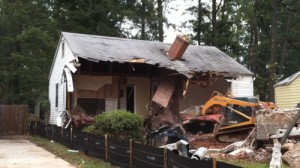Preservation conversations: When history at work is history at home (Part I)
14 September 2012 – David Rotenstein
What if after you bought the historic house of your dreams in a neighborhood that billed itself as “historic” you found out that your definition of historic clashed with that of your new neighbors? As a historian with nearly thirty years under my belt in history and historic preservation, that’s precisely what happened in 2011 when my wife and I bought a small Craftsman-influenced home in a Decatur, Georgia, neighborhood.
Our Decatur home was built in 1925 on a quiet street less than one block in from the tree-lined street that once carried the Gilded Age streetcar line that connected Atlanta to Decatur and which spurred development of the community in the years bracketing the turn of the twentieth century. Sure, there were some outsized and out-of-character infill homes and houses built on teardown sites, but the numbers didn’t strike us as anything out of the ordinary for a thriving urban neighborhood.
I had been aware that in 2007 local historic preservation advocates had tried, and failed, to have the neighborhood designated as a local historic district. And, considering how much the community (and city’s) marketing efforts focused on its historic character, I held out hope that the community’s historic buildings, landscapes, and diverse population might get another chance sometime in the future.
As a low-overhead history consultant, I worked out of our house once we moved in the first week of September 2011. I enjoy walking and talking to people and I regularly rode my bike through the neighborhood on my way to the regional trail network. It didn’t take long for me to notice the unusual amount of new construction underway–construction that didn’t appear to be occurring as we were hunting for a house earlier that spring and summer.
The morning of October 19, 2011, I was out for a walk and saw a crew dismantling a small house just three blocks away from us. It was a small (three-person) crew deconstructing a small (1,100 square feet) house using a small front-end skidder. I was transfixed by the workmanlike manner of these people with their small piece of equipment deconstructing the small house so I whipped out the iPhone and began shooting video.
By four o’clock that afternoon and after several return visits with the iPhone, the house had been reduced to a pile of rubble. I had interviewed the builder who admitted the only thing wrong with the 1940s-vintage house was its size. It had to go to accommodate a larger home, presumably for a family with children bound for the city’s charter school system.
The next day I hit the DeKalb County courthouse and began researching the property. Until earlier in 2011, the house had been owned by a woman who had bought it from the Decatur Housing Authority in 1981 for one dollar. Shirley Huff, who had died May 28, 2011, was one of 113 people whose numbers had been pulled from a glass fishbowl by city officials and who became homebuyers under the Urban Homesteading Demonstration Program authorized under the Housing and Development Act of 1974.
I had known about the urban homesteading program but Decatur as a pilot city never really registered in my first exposure to the program designed to spur reinvestment in neighborhoods blighted by foreclosed and abandoned homes. After revisiting the urban redevelopment literature, I found that Decatur had been one of the first 23 cities, and the smallest, to be accepted into the experimental program in 1975. The neighborhood where we had moved had been Decatur’s targeted urban homesteading neighborhood.
By the first week in November I had identified all of the former urban homesteading sites in what used to be known as South Decatur. County land records showed that a surprising 10 percent of the original buyers still owned and lived in the homes. But as the informal survey to identify the former homesteading sites progressed, I also became increasingly aware of the number of buildings torn down and replaced by homes two or three times the size of the earlier homes and sporting a wide array of architectural finishes.
As I was looking for dollar homes, I also was finding $700,000 McMansions built at some of the urban homesteading sites and juxtaposed against surviving and much smaller brick period revival homes, frame bungalows, and modest brick ranch houses. South Decatur was filling with faux Prairies and Hardiplank-clad foursquares designed to recreate the wealthier and larger early twentieth century homes built adjacent to nearby Agnes Scott College. I had started interviewing current and former urban homesteaders about their experiences and their homes; later interviews with other residents and city officials soon veered towards gentrification, displacement, white privilege, and the environment.
We were committed to the neighborhood and we had invested some serious money buying the house, personalizing it, and making it energy efficient. The house was going to be our home for a long time, or so we thought. Yet, as I was learning about South Decatur’s housing history, I also was learning about Decatur’s history of urban renewal and an undercurrent of racial tensions among African Americans who have never felt fully part of the community.
Read Part II of this piece.
This video was assembled by the author from an April 2012 interview recording and footage of home demolition and construction in his Decatur neighborhood.
~ David S. Rotenstein (Historian for Hire) is an independent consultant working in Atlanta, Washington DC, and beyond.





Wow and thankyou! Keep at it.
There’s a seminar on 29 September in Baltimore about the very successful dollar house program there.
http://pigtown-design.blogspot.com/2012/09/a-dollar-just-dollar.html